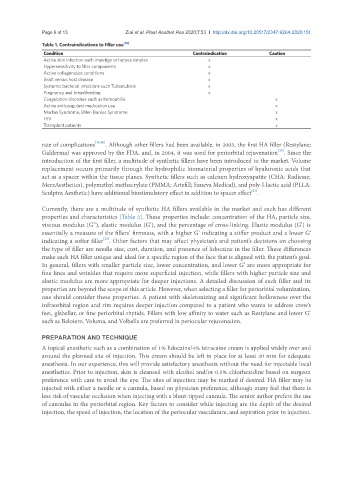Page 614 - Read Online
P. 614
Page 6 of 13 Ziai et al. Plast Aesthet Res 2020;7:53 I http://dx.doi.org/10.20517/2347-9264.2020.151
Table 1. Contraindications to filler use [18]
Condition Contraindication Caution
Active skin infection such impetigo or herpes simplex x
Hypersensitivity to filler components x
Active collagenoses conditions x
Graft versus host disease x
Systemic bacterial infections such Tuberculosis x
Pregnancy and breastfeeding x
Coagulation disorders such as hemophilia x
Active anticoagulant medication use x
Marfan Syndrome, Ehler-Danlos Syndrome x
HIV x
Transplant patients x
rate of complications [19,20] . Although other fillers had been available, in 2003, the first HA filler (Restylane;
Galderma) was approved by the FDA, and, in 2004, it was used for periorbital rejuvenation . Since the
[20]
introduction of the first filler, a multitude of synthetic fillers have been introduced to the market. Volume
replacement occurs primarily through the hydrophilic biomaterial properties of hyaluronic acids that
act as a spacer within the tissue planes. Synthetic fillers such as calcium hydroxyapatite (CHA: Radiesse;
MerzAesthetics), polymethyl methacrylate (PMMA; Artefill; Suneva Medical), and poly-l-lactic acid (PLLA:
[21]
Sculptra Aesthetic) have additional biostimulatory effect in addition to spacer effect .
Currently, there are a multitude of synthetic HA fillers available in the market and each has different
properties and characteristics [Table 2]. These properties include: concentration of the HA, particle size,
viscous modulus (G’’), elastic modulus (G’), and the percentage of cross-linking. Elastic modulus (G’) is
essentially a measure of the fillers’ firmness, with a higher G’ indicating a stiffer product and a lower G’
[22]
indicating a softer filler . Other factors that may affect physician’s and patient’s decisions on choosing
the type of filler are needle size, cost, duration, and presence of lidocaine in the filler. These differences
make each HA filler unique and ideal for a specific region of the face that is aligned with the patient’s goal.
In general, fillers with smaller particle size, lower concentration, and lower G’ are more appropriate for
fine lines and wrinkles that require more superficial injection, while fillers with higher particle size and
elastic modulus are more appropriate for deeper injections. A detailed discussion of each filler and its
properties are beyond the scope of this article. However, when selecting a filler for periorbital volumization,
one should consider these properties. A patient with skeletonizing and significant hollowness over the
infraorbital region and rim requires deeper injection compared to a patient who wants to address crow’s
feet, glabellar, or fine periorbital rhytids. Fillers with low affinity to water such as Restylane and lower G’
such as Belotero, Voluma, and Volbella are preferred in periocular rejuvenation.
PREPARATION AND TECHNIQUE
A topical anesthetic such as a combination of 1% lidocaine/4% tetracaine cream is applied widely over and
around the planned site of injection. This cream should be left in place for at least 20 min for adequate
anesthesia. In our experience, this will provide satisfactory anesthesia without the need for injectable local
anesthetics. Prior to injection, skin is cleansed with alcohol and/or 0.5% chlorhexidine based on surgeon
preference with care to avoid the eye. The sites of injection may be marked if desired. HA filler may be
injected with either a needle or a cannula, based on physician preference, although many feel that there is
less risk of vascular occlusion when injecting with a blunt-tipped cannula. The senior author prefers the use
of cannulas in the periorbital region. Key factors to consider while injecting are the depth of the desired
injection, the speed of injection, the location of the periocular vasculature, and aspiration prior to injection.

